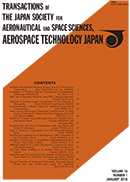Volume 10
Displaying 1-7 of 7 articles from this issue
- |<
- <
- 1
- >
- >|
-
Article type: Research Note
Subject area: Aerodynamics
2012 Volume 10 Pages 1-4
Published: 2012
Released on J-STAGE: June 02, 2012
Download PDF (352K) -
Article type: Research Note
Subject area: Materials
2012 Volume 10 Pages 5-9
Published: 2012
Released on J-STAGE: June 27, 2012
Download PDF (595K) -
Article type: Research and Development Report
Subject area: Structures
2012 Volume 10 Pages 11-16
Published: 2012
Released on J-STAGE: June 02, 2012
Download PDF (397K) -
Article type: Full Article
Subject area: Structures
2012 Volume 10 Pages 17-26
Published: 2012
Released on J-STAGE: July 26, 2012
Download PDF (336K) -
Article type: Full Article
Subject area: Structures
2012 Volume 10 Pages 27-32
Published: 2012
Released on J-STAGE: August 28, 2012
Download PDF (1785K) -
Article type: Full Article
Subject area: Aircraft Design
2012 Volume 10 Pages 33-42
Published: 2012
Released on J-STAGE: October 10, 2012
Download PDF (1739K) -
Article type: Full Article
Subject area: Materials
2012 Volume 10 Pages 43-50
Published: 2012
Released on J-STAGE: December 26, 2012
Download PDF (744K)
- |<
- <
- 1
- >
- >|
